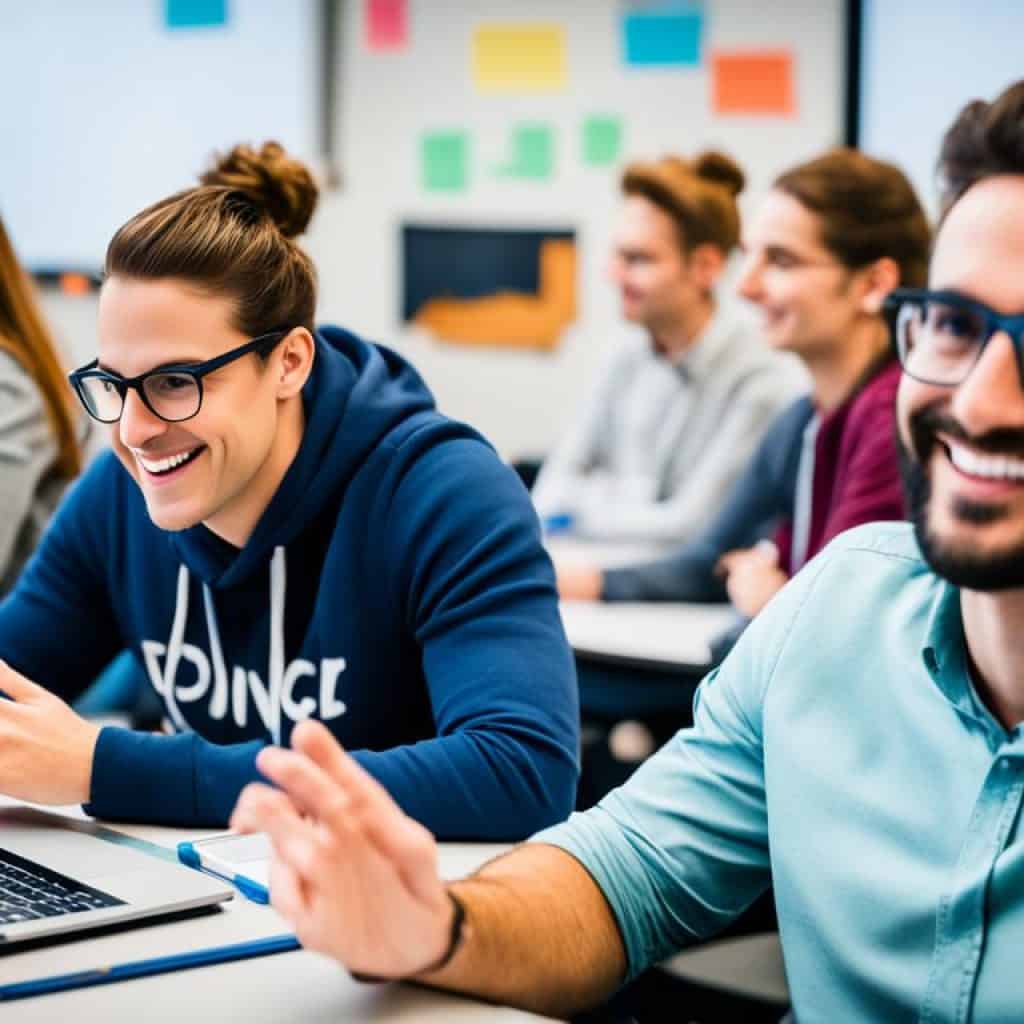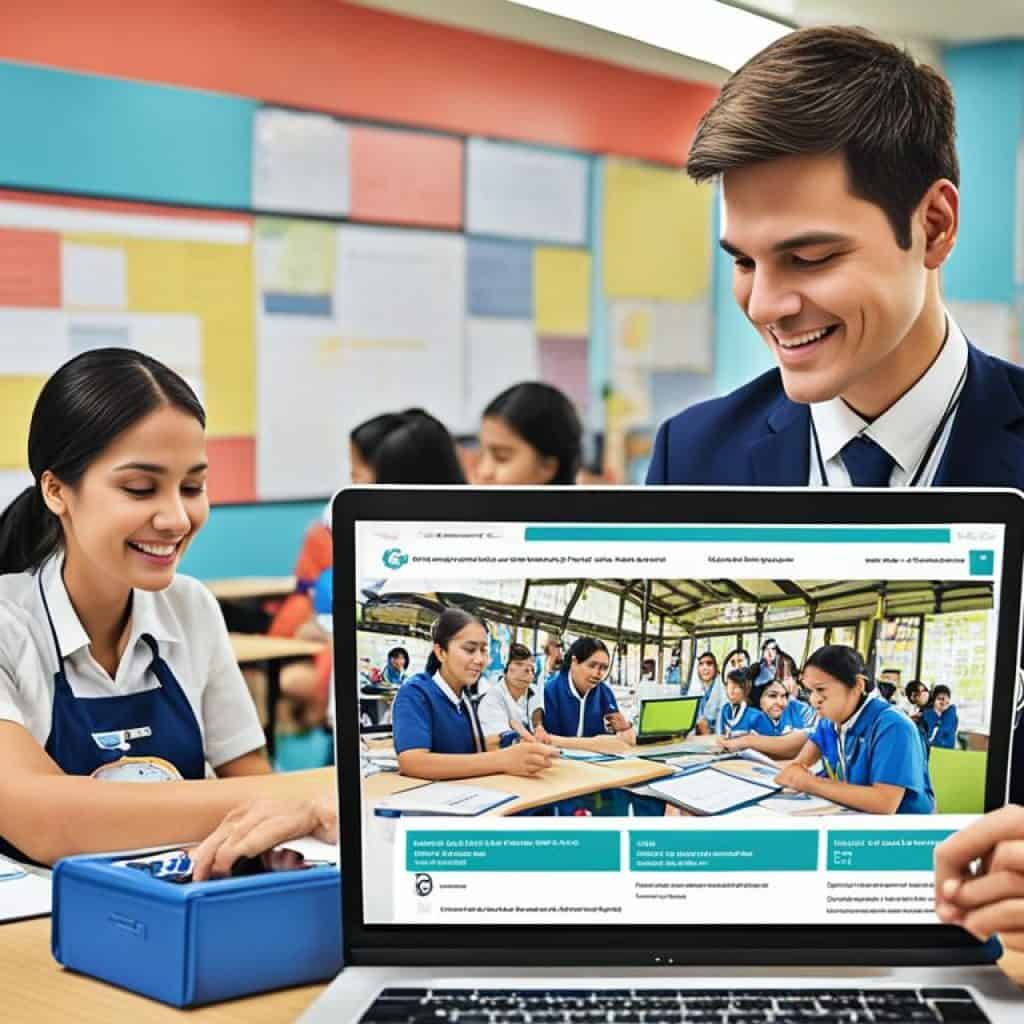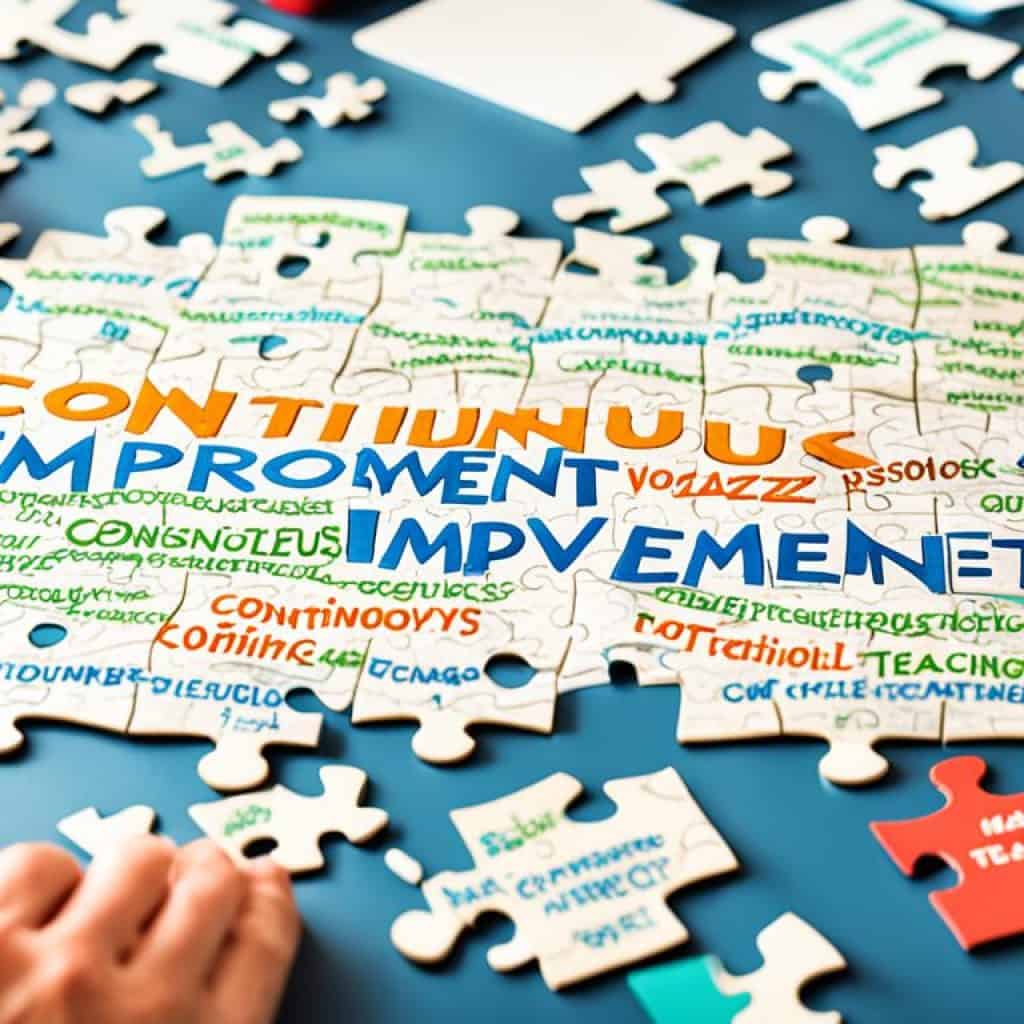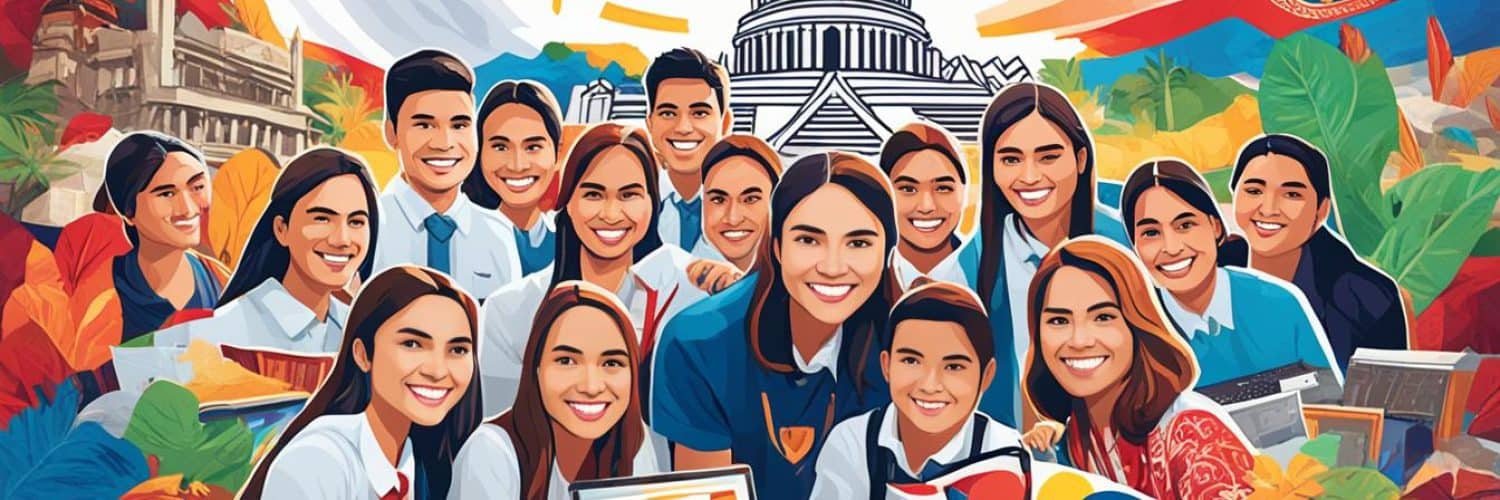Blended learning is revolutionizing education in the Philippines. With the increasing demand for online education and the advancements in technology, educators are harnessing the power of blended learning to create flexible and engaging learning experiences for students. But what exactly is blended learning, and how is it shaping the future of education in the Philippines?
This article explores the key trends and insights surrounding blended learning in the Philippines. From virtual classrooms and digital learning platforms to hybrid learning models and remote learning solutions, we delve into the transformative impact of blended learning on education in the country.
Key Takeaways:
- Blended learning combines traditional face-to-face instruction with online learning modalities.
- Blended learning offers flexibility, personalized learning, and access to educational resources.
- Challenges in blended learning include technological, instructional, and collaboration roadblocks.
- The integration of ICT is crucial for facilitating blended learning experiences.
- Blended learning has a positive impact on students’ academic achievement.
Challenges and Roadblocks in Blended Learning
The implementation of blended learning in the Philippines poses several challenges and roadblocks that hinder the effective delivery of teaching and learning. A qualitative case study investigating facilitators teaching the National Service Training Program (NSTP) identified five main themes or “roadblocks” in blended learning: technological, instructional, class size, technical support, and collaboration.
Technological challenges arise from limited access to technology and digital tools, which can impede students’ ability to fully engage in online learning activities. Instructional challenges involve designing and delivering content in a blended format that accommodates both face-to-face and online learning environments.
Class size challenges emerge when managing larger groups of students in both online and offline settings. As class sizes increase, it becomes more difficult for teachers to provide individualized attention and support to each student.
Technical support challenges occur when technical issues disrupt the smooth functioning of blended learning environments. Facilitators and students may encounter difficulties with software, connectivity, or other technical aspects, impacting their overall learning experience.
Collaboration challenges encompass fostering meaningful collaboration among students and between students and facilitators. Blended learning requires a strong sense of community and effective communication channels to facilitate collaborative learning experiences.
Addressing these challenges is essential for a successful blended learning implementation. Educational institutions and policymakers must work together to provide access to technology, prioritize teacher training and support, and establish effective systems for technical assistance and collaboration.
The Role of ICT in Blended Learning
Blended learning in the Philippines is greatly enhanced by the integration of Information and Communication Technologies (ICTs). With the increasing accessibility of the internet and technology, ICT plays a crucial role in facilitating a seamless and engaging blended learning experience.
By leveraging ICT, educators can tap into a vast array of online learning resources and educational technologies. These resources provide students and teachers with flexible learning options, allowing them to access and share information conveniently. The integration of ICT in the education sector opens doors to personalized learning experiences, fostering student motivation and achievement.
Blended learning, driven by ICT, has the potential to revolutionize the way education is delivered and experienced in the Philippines. It empowers educators to create interactive and dynamic learning environments, catering to diverse student needs and learning styles. Through the integration of technology, blended learning promotes active learning and empowers students to take ownership of their education.
Teachers’ Perceptions of Blended Learning
Teachers’ perceptions of blended learning in the Philippines can vary, with some recognizing its benefits and others facing barriers to its implementation. These perceptions are influenced by several factors, including understanding blended learning concepts, access to ICT training, confidence in using blended learning approaches, and institutional support.
Professional development plays a crucial role in addressing these barriers and empowering teachers to effectively integrate blended learning strategies into their classrooms. By providing teachers with the necessary training and support, educational institutions can help them navigate the challenges of blended learning and maximize its potential.
Teachers who have successfully implemented blended learning have acknowledged its numerous benefits. Blended learning offers increased flexibility, allowing students to learn at their own pace and access a variety of learning resources. It also promotes learner autonomy, empowering students to take ownership of their education and explore topics that interest them.
Moreover, blended learning provides opportunities for students to develop essential digital literacy and technology skills, preparing them for the demands of the modern workforce. By combining face-to-face instruction with online learning modalities, blended learning caters to different learning styles and fosters active engagement in the learning process.
However, there are also barriers that teachers may encounter when implementing blended learning. These barriers can include a lack of access to technology and reliable internet connectivity, limited time for planning and preparation, and resistance to change from students or colleagues.
“Blended learning allows teachers to personalize instruction and cater to the individual needs of their students. It empowers students to take ownership of their learning journey and provides a wealth of resources that can enhance their educational experience.” – Teacher testimonial
Overcoming these barriers requires support from educational institutions and ongoing professional development opportunities. Recognizing the importance of blended learning, institutions should invest in infrastructure and resources to ensure access to technology for both teachers and students.
Collaboration among educators is also essential in sharing best practices and overcoming implementation challenges. By learning from one another’s experiences and sharing innovative ideas, teachers can collectively drive the successful adoption of blended learning.
Table: Benefits and Barriers of Blended Learning
| Benefits of Blended Learning | Barriers to Blended Learning |
|---|---|
| Increased flexibility | Lack of access to technology |
| Learner autonomy | Limited time for planning and preparation |
| Access to a variety of learning resources | Resistance to change |
| Development of digital literacy and technology skills |
Learning Communities in Blended Learning
Blended learning environments in the Philippines foster the development of learning communities, where interaction, collaboration, and knowledge construction occur among students and teachers. These communities are essential for creating engaging and meaningful learning experiences that go beyond the traditional classroom setting.
The Community of Inquiry (CoI) framework provides a conceptual framework to understand the nature of these learning communities. According to the CoI framework, there are three key elements that contribute to building effective learning communities: cognitive presence, social presence, and teaching presence.
Cognitive presence: This refers to the learners’ ability to construct and confirm meaning through reflection and discourse. Blended learning environments encourage critical thinking, problem-solving, and deep understanding through interactive activities and discussions. Through cognitive presence, students develop higher-order thinking skills and actively engage in knowledge construction.
Social presence: Social presence involves the development of personal and affective relationships among community members, fostering a sense of belonging and trust. Blended learning platforms provide opportunities for students to connect with their peers and teachers, creating a supportive and collaborative learning environment. Social presence enhances engagement, motivation, and active participation in learning activities.
Teaching presence: Teaching presence focuses on the design, facilitation, and direction of learning processes for meaningful outcomes. In blended learning environments, teachers play a crucial role in guiding and supporting students’ learning journeys. They create and manage instructional materials, facilitate discussions, and provide timely feedback, ensuring that students receive quality education even in the online realm.
By nurturing cognitive presence, social presence, and teaching presence, blended learning environments in the Philippines promote active and engaging learning experiences. Through collaborative activities, online discussions, and personalized feedback, students develop a deep understanding of the subject matter, build meaningful relationships with their peers, and receive guidance from their teachers.

Blended learning encourages the creation of tight-knit learning communities that support students’ academic growth and foster their sense of belonging. Through the integration of technology and collaborative activities, students become active participants in their own learning, benefitting from the diverse perspectives and experiences of their peers. The development of strong learning communities in blended learning environments enhances the overall learning experience and prepares students to thrive in today’s interconnected world.
The Impact of Blended Learning on Academic Achievement
Blended learning has emerged as a powerful educational approach in the Philippines, and numerous studies have been conducted to explore its impact on students’ academic achievement. The results of meta-analytic assessments have consistently demonstrated that blended learning yields better academic outcomes compared to traditional face-to-face instruction.
Students engaged in blended learning experience superior knowledge attainment and higher levels of learning engagement. The combination of online and offline learning modalities provides students with unique opportunities for personalized, self-paced learning, and access to a wide range of educational resources.
Blended learning allows teachers to integrate technology, pedagogy, and student-centered approaches into their instruction, resulting in improved academic outcomes. By leveraging online platforms, students can engage in interactive and immersive learning experiences that cater to their individual needs and learning preferences.
Moreover, student engagement plays a critical role in academic achievement, and blended learning excels in this area. It offers a dynamic and interactive learning environment that fosters active participation and collaboration.
Blended learning enhances student engagement by providing a balance between face-to-face instruction and online activities. Students can engage in discussions, group work, and projects both inside and outside the physical classroom, promoting deep learning and critical thinking.
Blended learning also encourages students to take ownership of their learning journey and develop self-regulated learning skills. The flexibility and autonomy it provides empower students to manage their time effectively and take responsibility for their educational progress.
Overall, the impact of blended learning on academic achievement in the Philippines is significant. By combining the strengths of face-to-face instruction and online learning, blended learning equips students with the knowledge, skills, and competencies necessary for success in the digital age.
| Blended Learning | Traditional Face-to-Face Instruction | |
|---|---|---|
| Knowledge Attainment | Superior | Standard |
| Learning Engagement | Higher levels | Varies |
| Student Autonomy | Promotes self-regulated learning | Limited |
| Access to Resources | Wide range of online resources | Physical textbooks and materials |
As seen in the table above, the benefits of blended learning are evident. Students engaged in blended learning consistently outperform their counterparts in traditional face-to-face settings in terms of knowledge attainment, learning engagement, student autonomy, and access to educational resources.
Blended Learning Models and Approaches
In the Philippines, blended learning encompasses various models and approaches that cater to the diverse needs and preferences of students. These models provide a framework for combining face-to-face instruction with online components, creating flexible learning options in K-12 education. Blended learning models enable customization of learning experiences, promoting personalized education for each student.
Educational technology plays a crucial role in facilitating these models, providing access to digital learning platforms, collaborative tools, and interactive resources. These technologies enhance student engagement and interaction, fostering an immersive learning environment. With the integration of educational technology, blended learning models empower students to take control of their learning, making the educational experience more dynamic and interactive.
The following are some of the prominent blended learning models and approaches used in the Philippines:
- Rotation Model: In this model, students rotate between different learning stations, including online learning, small group instruction, and independent work. This allows for a mix of individualized and collaborative learning experiences.
- Flex Model: The flex model combines online learning with traditional face-to-face instruction. Students have the flexibility to choose the time, place, and pace of their learning, while teachers provide guidance and support.
- Self-Blend Model: In the self-blend model, students supplement their traditional classroom instruction with online learning to explore specific topics or enhance their understanding. This model promotes self-directed learning and personalized exploration.
- Enriched Virtual Model: The enriched virtual model combines face-to-face instruction with online learning. Most of the content is delivered online, with face-to-face sessions focusing on interactive discussions, collaborative activities, and hands-on learning.
- Distance Learning: Distance learning, often used in rural areas with limited access to school facilities, relies heavily on online resources and virtual communication platforms. Students engage in remote learning, facilitated by teachers through digital means.
Blended learning models provide the flexibility and adaptability needed to meet the unique needs of students and the demands of the modern education landscape. By leveraging educational technology and embracing these models and approaches, the Philippines can create a dynamic and engaging learning environment that prepares students for the future.
Best Practices in Blended Learning Implementation
Implementing blended learning effectively requires incorporating best practices and adopting a student-centered approach. By following these strategies, educators can create engaging and impactful learning experiences for their students:
- Designing Engaging and Interactive Learning Activities: Create activities that actively involve students in their own learning. Incorporate multimedia elements, simulations, and interactive exercises to enhance engagement and promote deeper understanding.
- Providing Continuous Feedback and Assessment Opportunities: Offer regular feedback to students on their progress and provide opportunities for self-assessment and reflection. Use a variety of assessment tools, such as quizzes, projects, and discussions, to gauge student understanding and adjust instruction accordingly.
- Promoting Collaboration and Communication Among Students: Foster a collaborative learning environment by encouraging students to work together on projects, discussions, and problem-solving activities. Utilize online platforms and tools that facilitate communication and collaboration, such as discussion boards and group workspaces.
- Ensuring Access to Technology and Online Resources: Provide students with the necessary technology and access to online resources to support their blended learning experience. This may involve securing devices, ensuring internet connectivity, and providing access to digital learning platforms and educational tools.
Furthermore, teacher support and training are essential for successful blended learning implementation. Educators should be provided with professional development opportunities that equip them with the necessary skills and knowledge to effectively integrate blended learning strategies into their instructional practices. Ongoing mentoring and technical support should be available to address any challenges or concerns that may arise.
By following these best practices and prioritizing student-centered approaches, educators can maximize the benefits of blended learning and create transformative learning experiences for their students.
Evaluating the Impact of Blended Learning Programs
Evaluating blended learning programs is essential to assess student outcomes, measure program effectiveness, and make data-driven decisions. Through comprehensive evaluation processes, educational institutions can continuously improve their blended learning initiatives and ensure high-quality education for students.
When evaluating blended learning programs, a combination of qualitative and quantitative assessments is crucial. It involves collecting data on student performance, engagement, and achievement, as well as gathering feedback from both students and teachers. By analyzing this data, institutions gain valuable insights into the effectiveness of their programs and can identify areas for improvement.
One method of evaluation is qualitative assessment, which involves gathering feedback from students and teachers through surveys, interviews, and focus groups. This qualitative data provides valuable insights into the learners’ experiences, challenges, and perceptions of blended learning. It helps identify strengths, weaknesses, and areas needing further development.
“Blended learning has transformed my teaching practice. It has helped me understand my students’ individual needs and tailor instruction accordingly. The feedback from students has been overwhelmingly positive, with improved engagement and motivation.” – Teacher
Quantitative assessment, on the other hand, focuses on measuring student outcomes and academic achievement. This includes analyzing test scores, grades, and other quantitative data to determine the impact of blended learning on student learning outcomes. By comparing these data with pre-implementation benchmarks, institutions can gauge program effectiveness and determine whether their blended learning initiatives are achieving the desired results.
Data-driven decision making is at the core of evaluating blended learning programs. By using the data collected from evaluations, institutions can identify areas of success and areas that need improvement. These data-driven insights can guide instructional improvements, curriculum adaptations, and the development of evidence-based practices in blended learning.
Methods of Evaluating Blended Learning Programs
| Methods | Benefits |
|---|---|
| Qualitative Assessment | – Provides insights into learner experiences and perceptions – Identifies strengths and weaknesses of blended learning programs – Informs instructional improvements and design modifications |
| Quantitative Assessment | – Measures student outcomes and academic achievement – Determines program effectiveness – Compares results with pre-implementation benchmarks |
| Data-driven Decision Making | – Guides instructional improvements and adaptations – Informs curriculum development – Enhances evidence-based practices in blended learning |
By systematically evaluating blended learning programs, educational institutions can make informed decisions, continuously improve instructional practices, and provide the best possible education for their students. This ongoing evaluation ensures that blended learning remains an effective and impactful approach to education in the Philippines and beyond.

The Future of Blended Learning in the Philippines
The future of blended learning in the Philippines holds immense potential, driven by ongoing advancements in educational technology and a strategic focus on digital transformation in education. As emerging technologies such as artificial intelligence, virtual reality, and adaptive learning platforms continue to evolve, they will revolutionize the possibilities of blended learning.
One of the key aspects that will shape the future of blended learning is personalized learning. With the increasing understanding of students’ diverse needs and preferences, educational institutions in the Philippines will tailor learning experiences to cater to individual students. This approach will enable learners to take ownership of their education, making it more engaging, relevant, and effective.
Furthermore, blended learning will continue to adapt and evolve based on research, feedback from students and teachers, and the changing educational landscape. Educational institutions will harness the adaptability and flexibility of blended learning to address the dynamic challenges faced in the Philippines’ educational system.
Educational technology advancements will play a central role in transforming the future of blended learning. As digital tools and platforms become more sophisticated, they will facilitate seamless and immersive learning experiences for students. The integration of these technologies will enhance collaboration, interactive learning, and engagement, fostering a deeper understanding of complex concepts.
Blended learning, fueled by educational technology advancements, will bridge the gaps in education accessibility, allowing students from diverse backgrounds and geographical locations to access high-quality learning experiences. This inclusivity will contribute to a more equitable education system in the Philippines, ensuring that all students have equal access to educational opportunities.
In conclusion, the future of blended learning in the Philippines looks promising. Continued advancements in educational technology, the focus on digital transformation, personalized learning experiences, and the adaptability of blended learning will shape the future of education. By embracing these trends, the Philippines can empower its learners, enhance academic outcomes, and establish an inclusive education system that prepares students for the challenges of the future.
Addressing Barriers and Challenges in Blended Learning
Blended learning offers numerous benefits in education, but it also comes with its fair share of challenges. However, by proactively addressing these barriers, educational institutions can ensure a smooth and effective implementation of blended learning.
Professional Development for Teachers
One of the key challenges in blended learning is equipping teachers with the necessary skills and knowledge to effectively integrate technology into their instructional practices. Professional development programs focused on technology integration, instructional design, and pedagogical approaches can empower teachers to overcome these challenges. These programs can provide teachers with the necessary support, resources, and strategies to navigate the complexities of blended learning and enhance their teaching effectiveness.
Infrastructure and Connectivity
Ensuring adequate infrastructure and internet connectivity is crucial for delivering a seamless blended learning experience. Educational institutions must invest in reliable internet connections, sufficient bandwidth, and appropriate hardware to support the delivery of online content. Accessible technology and a robust digital infrastructure lay the foundation for a successful blended learning environment.
Student Support Services
Engaging in blended learning can pose unique challenges for students. Technical issues, difficulties in self-paced learning, and limited social interaction can impact student engagement and success. To address these challenges, educational institutions should provide comprehensive student support services. These services can include technical assistance, tutoring, counseling, and platforms for collaboration to foster a sense of community and support students’ academic and emotional well-being.
| Challenges | Solutions |
|---|---|
| Technology integration | Professional development programs for teachers |
| Instructional design | Professional development programs for teachers |
| Pedagogical approaches | Professional development programs for teachers |
| Infrastructure and internet connectivity | Investment in reliable technology and digital infrastructure |
| Student engagement and support | Comprehensive student support services |
Addressing these barriers and challenges in blended learning is crucial for its successful implementation. By providing professional development for teachers, ensuring adequate infrastructure and connectivity, and offering comprehensive student support services, educational institutions can create an environment that promotes effective teaching and learning in a blended format.
Promoting Equity in Blended Learning
Promoting equity in blended learning is crucial to ensure equal access to educational opportunities for all students. By bridging the digital divide and addressing disparities in access to technology, educational institutions can create a more inclusive and accessible learning environment.
To bridge the digital divide, it is essential to provide students with access to technology and internet connectivity. This can be achieved through various initiatives, such as providing laptops or tablets to students from low-income backgrounds or ensuring that all students have access to reliable internet connections. By removing the barriers caused by limited access to technology, educational institutions can level the playing field and ensure that every student has the necessary tools to succeed in blended learning.
Inclusive education practices should also be integrated into blended learning environments. This involves providing the necessary support and accommodations for students with disabilities and diverse learning needs. Educational institutions can work towards creating a more inclusive environment by implementing Universal Design for Learning (UDL) principles, which promote multiple means of representation, expression, and engagement. By embracing inclusive education, blended learning can cater to the unique needs of every student, fostering a more equitable and supportive learning experience.
Furthermore, it is crucial to consider the socioeconomic background of students when delivering blended learning. Efforts should be made to ensure that students from different economic backgrounds have equal access to resources and technology. This can be achieved through partnerships with organizations that provide technology resources, scholarships, or other forms of financial assistance. By addressing disparities among students, educational institutions can create a more equitable learning environment and promote social mobility.
Promoting Equity in Blended Learning – Initiatives and Strategies
Here are some initiatives and strategies that can be implemented to promote equity in blended learning:
- Providing technology resources, such as laptops or tablets, to students from low-income backgrounds.
- Ensuring access to reliable internet connectivity for all students.
- Implementing Universal Design for Learning (UDL) principles to cater to students with diverse learning needs.
- Partnering with organizations to provide technology resources and financial assistance to students in need.
- Offering professional development programs for teachers to develop inclusive teaching practices.
Promoting Equity in Blended Learning – Benefits
Promoting equity in blended learning has numerous benefits, including:
- Providing equal educational opportunities for all students, regardless of their socioeconomic background.
- Closing the achievement gap by addressing disparities in access to technology and resources.
- Fostering a more inclusive and supportive learning environment.
- Empowering students with diverse learning needs to thrive in blended learning environments.
- Promoting social mobility by providing equal access to educational resources.
| Benefit | Description |
|---|---|
| Equal educational opportunities | By promoting equity in blended learning, every student has access to the same educational resources and opportunities, regardless of their socioeconomic background. |
| Closing the achievement gap | Addressing disparities in access to technology and resources helps close the achievement gap by providing all students with an equal chance to succeed. |
| Inclusive learning environment | Promoting equity in blended learning creates a more inclusive and supportive learning environment where every student feels valued and supported. |
| Empowering diverse learners | By catering to the unique needs of students with diverse learning needs, equity in blended learning empowers these learners to thrive in educational settings. |
| Promoting social mobility | Providing equal access to educational resources and opportunities enables students from all backgrounds to pursue their goals and aspirations, promoting social mobility. |
Collaboration and Partnerships in Blended Learning
Collaboration and partnerships are key drivers for successful implementation of blended learning in educational institutions. By collaborating with industry partners, technology providers, and other educational organizations, institutions can tap into a wealth of best practices, resources, and expertise. This collaboration enables the sharing of innovative ideas, effective strategies, and successful models that enhance the overall quality of blended learning programs.
Networking opportunities, conferences, and professional learning communities further facilitate collaboration among teachers, administrators, and education stakeholders in the Philippines. These platforms provide a space for educators to connect, exchange insights, and collaborate on projects that improve the delivery and outcomes of blended learning.
“Collaboration is the key to unlocking the full potential of blended learning.”
By working together and fostering a culture of collaboration, educational institutions can leverage the strengths and experience of their peers to optimize the benefits of blended learning. This collaboration promotes continuous improvement, encourages innovative practices, and ultimately drives positive change in education.
“Alone we can do so little, together we can do so much.” – Helen Keller
The power of partnerships in education cannot be underestimated. By forging strategic partnerships, educational institutions can access a wider range of resources, funding opportunities, and support systems that enhance the implementation of blended learning. Partnerships bridge gaps, foster innovation, and create a network of like-minded individuals committed to advancing education in the Philippines.
Benefits of Collaboration and Partnerships in Blended Learning:
- Exchange of best practices and successful models
- Access to a diverse range of resources and expertise
- Professional development and capacity building opportunities
- Enhanced curriculum design and instructional strategies
- Improved student engagement and outcomes
- Access to innovative technologies and tools
- Increased research and evidence-based practices
The Importance of Continuous Improvement in Blended Learning
Continuous improvement is key to maximizing the effectiveness of blended learning. In order to ensure the best possible outcomes for students, educational institutions must prioritize data analysis, feedback collection, and reflective practices.
By analyzing data on student performance, engagement, and satisfaction, schools can identify areas for improvement and make data-driven instructional adaptations. This allows educators to tailor their teaching methods to better meet the individual needs of students, leading to enhanced learning experiences.
Regular feedback from both students and teachers is crucial in the continuous improvement process. By actively seeking input from these stakeholders, educational institutions can gather valuable insights and gain a deeper understanding of the areas that require adjustment or enhancement.
Feedback provides a unique opportunity for reflection, allowing educators to critically evaluate their instructional strategies and make necessary adjustments. This iterative cycle of feedback, reflection, and adaptation fosters an environment of continuous growth and improvement in blended learning.
Adopting a culture of continuous improvement enables educational institutions to stay responsive to changing needs, technological advancements, and evolving pedagogical practices. By consistently seeking opportunities to refine and optimize blended learning approaches, schools can ensure that they deliver the highest quality education possible.
Benefits of Continuous Improvement in Blended Learning:
- Enhanced student engagement and motivation
- Improved student outcomes and achievement
- More personalized and effective instructional strategies
- Better alignment of teaching methods with learner preferences and goals
- Increased teacher satisfaction and professional growth
Data Analysis in Blended Learning:
Data analysis plays a crucial role in driving continuous improvement in blended learning. By analyzing relevant data, such as student performance metrics, assessment results, and learning analytics, educators can gain valuable insights into the effectiveness of their instructional approaches.
Through data analysis, schools can identify patterns, trends, and areas of improvement. This information can then be used to inform instructional design, curriculum development, and pedagogical decision-making. Data-driven insights enable educators to make evidence-based decisions and optimize learning experiences for students.
Feedback and Reflection in Blended Learning:
Feedback is an integral part of the continuous improvement process in blended learning. By actively seeking feedback from students and teachers, educational institutions can gain valuable insights into the effectiveness of their instructional practices.
Feedback should be viewed as a collaborative process that involves both the giver and receiver. It provides an opportunity for reflection and self-assessment, allowing educators to critically evaluate their teaching methods and make necessary adjustments. By embracing feedback and using it to inform future instructional decisions, educators can create a more student-centered and impactful learning environment.
Instructional Adaptations in Blended Learning:
Continuous improvement in blended learning requires instructional adaptations based on data analysis and feedback. Educators should be open to trying new instructional strategies, experimenting with different technologies, and making changes to their teaching approaches.
Adaptations may involve modifying content delivery methods, incorporating interactive learning activities, or providing additional support to students with diverse learning needs. By adapting instructional practices, educators can optimize student engagement, foster deeper understanding, and promote successful learning outcomes.

| Benefits of Continuous Improvement | Data Analysis Process | Feedback and Reflection | Instructional Adaptations |
|---|---|---|---|
| Enhanced student engagement and motivation | Collect relevant data | Seek feedback from students and teachers | Adapt instructional strategies |
| Improved student outcomes and achievement | Analyze data for patterns and trends | Reflect on feedback received | Experiment with different teaching methods |
| More personalized and effective instructional strategies | Use data insights to inform decisions | Incorporate feedback into instructional design | Provide additional support as needed |
| Better alignment of teaching methods with learner preferences and goals | Make evidence-based decisions | Encourage self-assessment and reflection | Modify content delivery methods |
| Increased teacher satisfaction and professional growth | Optimize learning experiences | Collaboratively use feedback for improvement | Incorporate interactive learning activities |
Conclusion
Blended learning in the Philippines is revolutionizing education by combining the strengths of traditional classroom instruction with online learning. This dynamic approach offers students flexibility, personalized learning experiences, and access to a wealth of digital resources. Despite the challenges and roadblocks faced in its implementation, blended learning has demonstrated significant benefits, including improved academic achievement and increased engagement among students.
The future of blended learning in the Philippines is promising, with continued advancements in educational technology and a focus on equity and continuous improvement. By addressing the challenges related to technology, infrastructure, and teacher training, educational institutions can create optimal learning environments. The nurturing of learning communities, fostering collaboration, and establishing partnerships with industry leaders and other educational organizations will further enhance the effectiveness of blended learning.
In conclusion, blended learning is reshaping education in the Philippines. Its impact on students’ academic achievement and engagement is undeniable. By harnessing the power of technology, embracing collaboration, and promoting continuous improvement, the potential of blended learning can be fully realized. Blended learning has the capacity to provide high-quality and inclusive education for all students, unlocking their true potential and preparing them for success in the 21st century.














Add comment